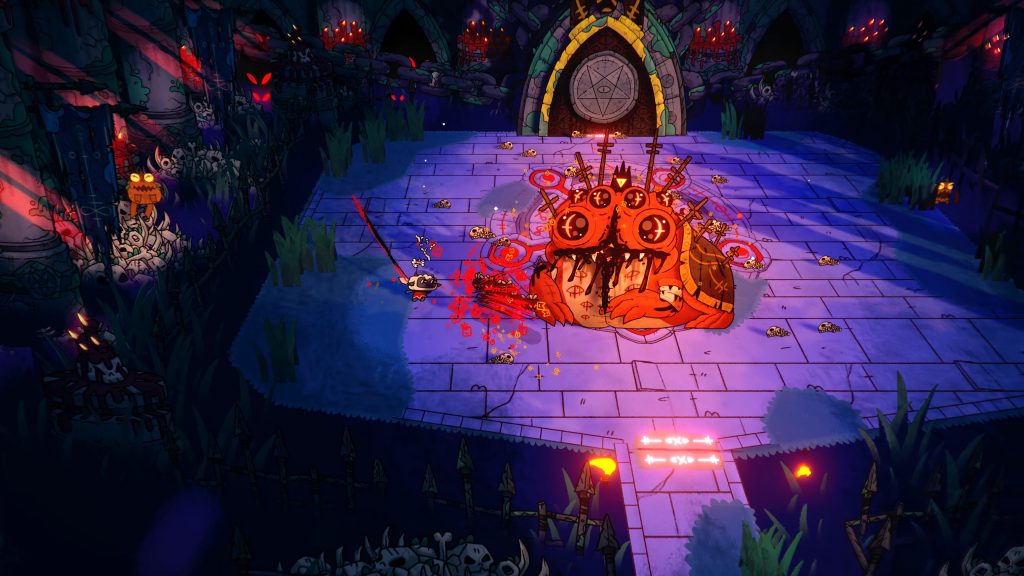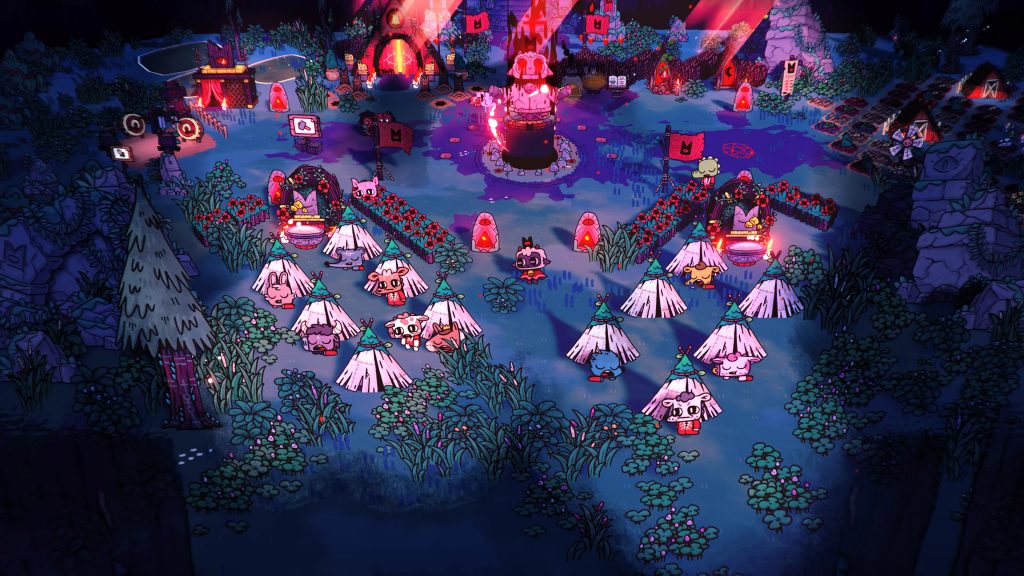As far as I can tell, Cult of the Lamb is mostly a game about poop. Picking poop up, throwing poop on crops. Feeding bowls of poop to unsuspecting critters. Feeding a second bowl of poop to the same critter because it was funny the first time. As it turns out though, there’s an entire game underneath this veritable fecal smorgasbord, and it’s been gently anticipated for quite some time now.
Cult of the Lamb is a gorgeous game, and that’s obvious from the start. The 2.5 art style makes the game resemble a twisted, horrific pop-up storybook – just with grotesque tentacle monsters and ritual sacrifice instead of castles and unicorns. Black and red overtones dominate the screen, with little splashes of muted colour here and there to bring Cult of the Lamb’s dark world to life. Artistically, this game is an instant 10. But does the carpet match the drapes?

The gameplay marries roguelite dungeon crawling with settlement building. Driven by a pact with a dark, slumbering god, your lost little lamb will crusade through randomly generated dungeons, scooping up resources and felling bosses to expand your cult and grow in power. In some regard, all the usual suspects are here. There’s an array of different weapons and spells, all of which able to be permanently upgraded, and modifiers/bonuses applied to your run by collectible tarot cards. There’s none of the fun body horror that comes with The Binding of Isaac, but there is an equal amount of poop to be found. Maybe more, actually.
Combat is snappy and satisfying at first. Melee attacks form the meat of your offensive capabilities, and these can be modified by picking up different weapons. Slaying enemies drops Fervour, which lets you utilise spells in short bursts. There’s a bunch of different types of weapons, but they all basically boil down to the same two styles – quick and weak, or slow and strong. There are a handful of perks that come along with them – like extra damaging effects or health regeneration – but these aren’t significant enough to change the flow of combat itself, and the Curses feel inefficient half the time.

After a relatively short time in-game, even with upgrades and the random aspects, Cult of the Lamb‘s combat just gets… boring. There’s so much of it, and your only real play style is attack – dodge roll – attack again. The 2.5 artwork actually works against it here as enemies disappear into the environment, hard to distinguish from the scenery. It’s only really, truly enjoyable in the boss fights that conclude every foray into the game’s dungeons. These bosses are huge, with attack patterns you can learn and adapt to on the fly. But when you’re just facing a horde of low level enemies, Cult of the Lamb just feels bland.
Basically everything you do comes with a reward. Clearing a room full of enemies will always drop a chest with gold and supplies, and the roguelite mechanics of the game are especially, well, lite. Death in Cult of the Lamb‘s dungeon just strips you of a small percentage of the items you’ve picked up and disappoints your followers slightly. You lose at the absolute most about ten-fifteen minutes of your time. Almost every time, you can go back to the next run stronger. Levelling up is tied directly to the wellbeing of your cult, which is almost an entirely separate affair to your dungeon crawling.

As mentioned above, Cult of the Lamb is a game of two halves. When you’re not slaying crazed gods or hoovering up treasure, you’ll be building up your cult’s base, which requires a lot of boring grunt work at the start. Throughout your travels you’ll rescue cute little animals, sending them directly to your base via convenient hell portal. These wayward strays form the backbone of your cult, eventually providing you with the power you’ll need to topple the four big bosses. But christ, if it isn’t a lot of work.
In the beginning it feels like you spend more time cooking and cleaning for your handful of followers as you do fighting monsters. It stops short of you actually having to deliver food to them by hand, but essentially all of the resources you earn will then be dumped into improving your cult and their quality of life. As you explore and gain their loyalty, you’ll earn the ability to make commandments, which shape which kind of eldritch cult operation you’re running. Will you bury your dead, or harvest their flesh and feed it back to them?

The bigger/more devoted your Cult is, the faster you’ll gain new abilities and unlock new buildings. The more buildings you have, the bigger and more beneficial your cult will be. You can take different paths by the rules you choose to set for your cult, but don’t assume this is a particularly deep feature – it’s just for flavour, and the outcomes will eventually be the same regardless of how you keep your cult in line. I still enjoyed watching my cult blossom into a proper operation, outfitted with proper sleeping quarters, outhouses and a thriving farm. But this leads into what is, in my opinion, Cult of the Lamb‘s biggest weakness.
The dungeon-crawling and the cult-building, despite their symbiotic nature, just don’t progress at the same rate. Playing normally, you’ll easily obtain most of the important upgrades and abilities long before you fight the fourth boss, essentially rendering finishing the game pointless. Upgrading your cult isn’t gated by progress through the dungeons, just the amount of worshippers/devotion you’re generating. Get enough followers mining enough resources, and you won’t be wanting for anything. This unbalance in the game’s two halves just throws it out of whack in a major way, especially combined with the monotonous, shallow combat.

I played Cult of the Lamb on PS5, and was really disappointed with some of the performance issues the game ran into on a regular basis. It seriously lags and hangs when moving from area to area, which isn’t too much of an inconvenience – where it really seems to struggle is in areas where lots of enemies and pickups are on the ground at once. Fervour – the game’s mana equivalent – drops on the ground from slain enemies. When too much of it drops, the game starts to lag, and eventually the Lamb just… can’t pick it up. This is really frustrating, especially given how rare a useful spell can be!
Cult of the Lamb overall thoughts
Cult of the Lamb‘s fantastic artwork and sound design unfortunately writes checks its gameplay can’t cash. It straddles the line between base-builder and rogue-like and never achieves greatness in either of those areas. The premise cannot be faulted, and the presentation is excellent. It’s like Don’t Starve and Adventure Time had a baby… and then sacrificed that baby to Cthulhu. The game beneath all that incredible artwork just falls a bit short of the mark, though, never managing to become as truly compelling as you want it to be. The loop of dungeon-running for resources and building up your cult will be addictive at first, but you might just burn out quickly.
I was really excited for Cult of the Lamb at first. In the first couple of hours of play I was sure this had game of the year potential for me. But the good ideas it has lose their charm quickly, and we’re left with something that just doesn’t quite scratch the itch. Neither half of the game is deep enough to satisfy fans, and while it’s worth playing for some casual fun, it probably won’t hold your attention for long.
Cult of the Lamb was developed by Massive Monster and published by Devolver Digital. It’s available now on Steam and your console of choice. Fancy reading more about some of this year’s biggest games? Check out our post here.